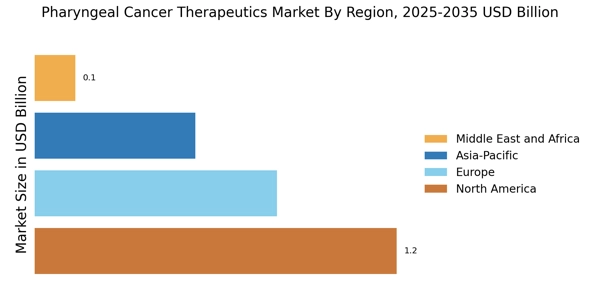Advancements in Treatment Modalities
Technological advancements in treatment modalities are significantly shaping the Pharyngeal Cancer Therapeutics Market. Innovations in surgical techniques, radiation therapy, and chemotherapeutic agents have enhanced treatment efficacy and patient outcomes. For instance, the introduction of minimally invasive surgical procedures has reduced recovery times and improved quality of life for patients. Additionally, the development of novel chemotherapeutic agents and targeted therapies has shown promise in improving survival rates. Market data suggests that the adoption of these advanced treatment options is increasing, as healthcare providers seek to offer the best possible care. This trend is likely to continue, as ongoing research and clinical trials yield new therapeutic options. As a result, advancements in treatment modalities are expected to play a crucial role in driving market growth and expanding the range of available therapies for pharyngeal cancer.
Growing Investment in Cancer Research
The growing investment in cancer research is a significant driver for the Pharyngeal Cancer Therapeutics Market. Increased funding from both public and private sectors is facilitating the exploration of new therapeutic approaches and technologies. This influx of capital is enabling researchers to conduct extensive studies on pharyngeal cancer, leading to the discovery of novel treatment options. Market data indicates that research funding has seen a substantial increase, with many organizations prioritizing cancer research initiatives. This trend is likely to foster collaboration among academic institutions, pharmaceutical companies, and healthcare providers, further accelerating the pace of innovation. As a result, the heightened investment in cancer research is expected to yield a plethora of new therapies, thereby enhancing the therapeutic landscape for pharyngeal cancer and driving market growth.
Rising Incidence of Pharyngeal Cancer
The increasing incidence of pharyngeal cancer is a primary driver for the Pharyngeal Cancer Therapeutics Market. Recent statistics indicate that the prevalence of this malignancy has been on the rise, particularly among certain demographics. Factors such as tobacco use, alcohol consumption, and the human papillomavirus (HPV) infection are contributing to this trend. As awareness of these risk factors grows, the demand for effective therapeutic options is likely to escalate. This surge in cases necessitates the development of innovative treatment modalities, thereby propelling the market forward. Furthermore, the need for early detection and intervention strategies is becoming increasingly apparent, which may lead to a greater focus on research and development within the industry. Consequently, the rising incidence of pharyngeal cancer is expected to significantly influence market dynamics in the coming years.
Increasing Awareness and Screening Programs
The increasing awareness of pharyngeal cancer and the implementation of screening programs are pivotal drivers for the Pharyngeal Cancer Therapeutics Market. Public health campaigns aimed at educating individuals about the symptoms and risk factors associated with pharyngeal cancer are gaining traction. These initiatives are likely to lead to earlier diagnosis and treatment, which can significantly improve patient outcomes. Furthermore, the establishment of screening programs is facilitating the identification of at-risk populations, thereby increasing the demand for therapeutic interventions. Market data suggests that regions with robust awareness campaigns and screening initiatives are witnessing a rise in diagnosed cases, which in turn drives the need for effective therapies. Consequently, the growing awareness and screening efforts are expected to play a crucial role in shaping the future of the pharyngeal cancer therapeutics market.
Regulatory Support for Innovative Therapies
Regulatory support for innovative therapies is emerging as a key driver for the Pharyngeal Cancer Therapeutics Market. Regulatory agencies are increasingly recognizing the need for expedited approval processes for novel treatments, particularly those that demonstrate significant therapeutic potential. This support is fostering an environment conducive to innovation, encouraging pharmaceutical companies to invest in the development of new therapies for pharyngeal cancer. Market data indicates that the number of expedited approvals has risen, reflecting a commitment to bringing effective treatments to market more swiftly. This trend is likely to continue, as regulatory bodies aim to address unmet medical needs in oncology. As a result, the regulatory support for innovative therapies is expected to significantly influence the growth trajectory of the pharyngeal cancer therapeutics market.


















Leave a Comment